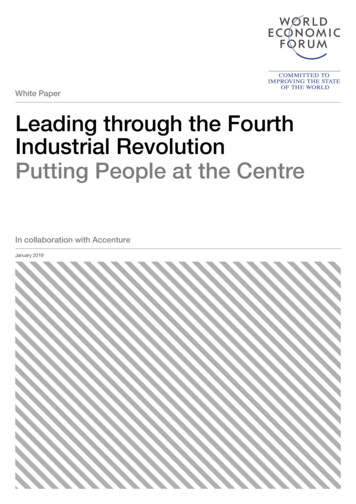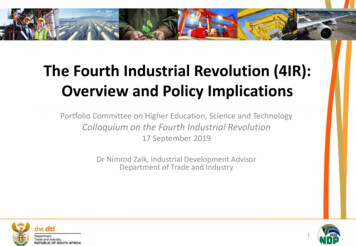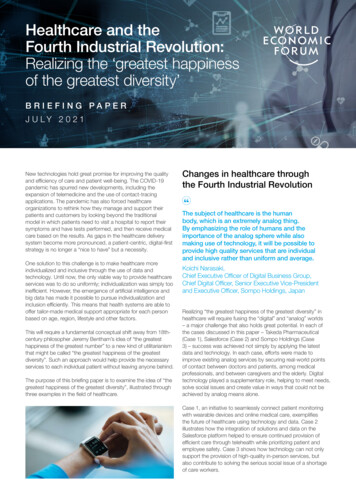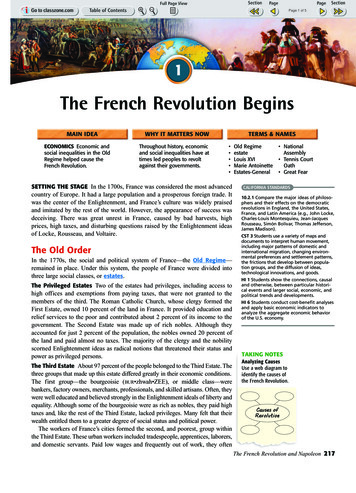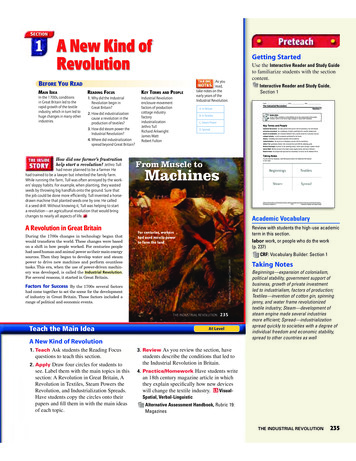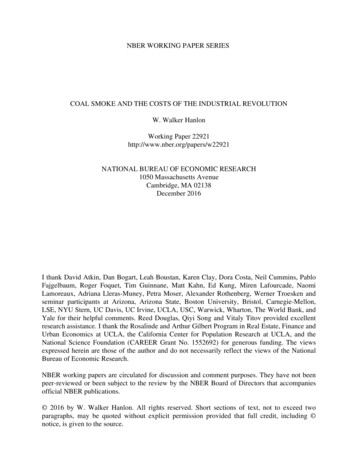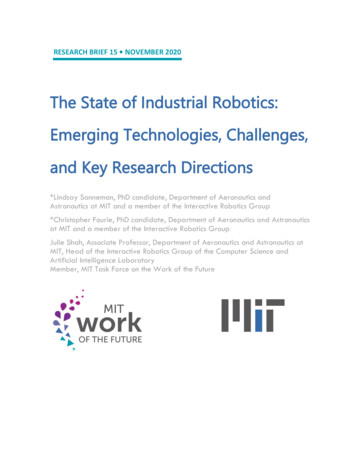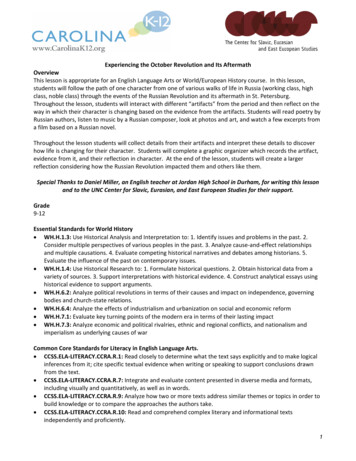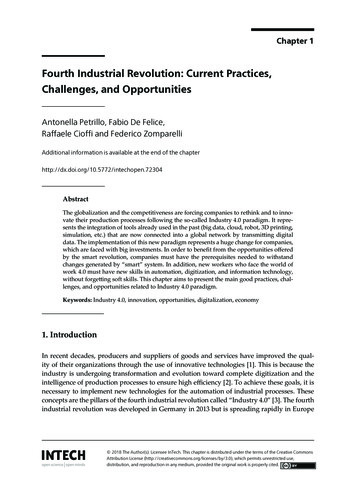
Transcription
DOI: 10.5772/intechopen.72304Provisional chapterChapter 1Fourth Industrial Revolution: Current Practices,Challenges,and OpportunitiesFourth IndustrialRevolution: Current Practices,Challenges, and OpportunitiesAntonella Petrillo, Fabio De Felice, Raffaele Cioffi andFederico ZomparelliAntonella Petrillo, Fabio De Felice,RaffaeleinformationCioffi andFedericoZomparelliAdditionalis availableat theend of the chapterAdditional information is available at the end of the bstractThe globalization and the competitiveness are forcing companies to rethink and to innovate their production processes following the so-called Industry 4.0 paradigm. It represents the integration of tools already used in the past (big data, cloud, robot, 3D printing,simulation, etc.) that are now connected into a global network by transmitting digitaldata. The implementation of this new paradigm represents a huge change for companies,which are faced with big investments. In order to benefit from the opportunities offeredby the smart revolution, companies must have the prerequisites needed to withstandchanges generated by “smart” system. In addition, new workers who face the world ofwork 4.0 must have new skills in automation, digitization, and information technology,without forgetting soft skills. This chapter aims to present the main good practices, challenges, and opportunities related to Industry 4.0 paradigm.Keywords: Industry 4.0, innovation, opportunities, digitalization, economy1. IntroductionIn recent decades, producers and suppliers of goods and services have improved the quality of their organizations through the use of innovative technologies [1]. This is because theindustry is undergoing transformation and evolution toward complete digitization and theintelligence of production processes to ensure high efficiency [2]. To achieve these goals, it isnecessary to implement new technologies for the automation of industrial processes. Theseconcepts are the pillars of the fourth industrial revolution called “Industry 4.0” [3]. The fourthindustrial revolution was developed in Germany in 2013 but is spreading rapidly in Europe 2016 The Author(s). Licensee InTech. This chapter is distributed under the terms of the Creative Commons 2018 TheAuthor(s).Licensee InTech. This chapter is distributedwhichunderpermitsthe termsof the ommons.org/licenses/by/3.0),unrestricteduse, mons.org/licenses/by/3.0),whichpermits unrestricted use,andreproductionin anymedium, provided the original work is properlycited.distribution, and reproduction in any medium, provided the original work is properly cited.
2Digital Transformation in Smart Manufacturingand the world as a whole [4]. This new work model focuses on the integrated man-machineapproach through “sustainable” production.The Industry 4.0 is based on the concept of smart factory, where the machines are integratedwith men through cyber-physical systems (CPS). In other words, Industry 4.0 is a new levelof organization that manages and controls the whole value chain of personalized productsto satisfy customer needs [5]. Digitalization is the most important element in Industry 4.0because it allows to connect man and technology [6].Industry 4.0 covers three fundamental aspects:1. Digitization and increased integration of vertical and horizontal value chains: development ofcustom products, customer’s digital orders, automatic data transfer, and integrated customer service systems.2. Digitization of product and service offerings: complete descriptions of the product and its related services through intelligent networks.3. Introduction of innovative digital business models: the high level of interaction between systems and technology opportunities develops new and integrated digital solutions. The basis of industrial Internet is the integrated and real-time availability and control of systemsacross the enterprise.The effect is a radical transformation of traditional industries that are changing their“approach” to the work. It means the use of new production technology, new machinery,new materials, and new inputs. In this context, knowledge has become the crucial input.Furthermore, a complete integration between the cyber and physical dimensions is occurred.Western civilization has passed through three stages of the industrial revolution, and thefourth revolution is in progress. An industrial revolution can be defined as a disruptive leapin the industrial process [7], a development that produces fundamental changes in the societyand the economy [8].Figure 1 describes the main phases that characterized industrial revolutions. The first industrial revolution was developed in the eighteenth century due to mechanical productionobtained by water and steam, with the development of machine tools and an improvementof their efficiency. The second industrial revolution developed with the arrival of electricityand mass production, theorized by Smith and Taylor and implemented by Henry Ford inhis Detroit factory for the production of the Model T. The third revolution was characterized by machine automation through the use of electronics and IT applied in the productionprocesses [9].The fourth industrial revolution integrates IT systems with physical systems to get a cyberphysical system that brings the real world in a virtual reality. There are also several opposing opinions. For example, The Economist [10] stated that the fourth industrial revolutionis only an evolution of the third industrial revolution. Harald Krüger, Chief ProductionOfficer at the BMW Group, instead, considers this development not as a fundamental revolution taking a huge digital leap forward. He explained that it is a constant development
Fourth Industrial Revolution: Current Practices, Challenges, and 72304Figure 1. Industrial revolutions.of technologies that will enable companies to achieve higher productivity, flexibility, aswell as enhanced product and service qualities [11]. Roland Berger [12] also mentioned thatthere are slow and steady changes in some areas and described some evolutionary effectsof this development. However, the majority of experts, including those in leading companies such as McKinsey & Company, Boston Consulting Group, Capgemini Consulting,Accenture, and General Electric have clearly pointed out the fundamental change of thisdevelopment considering this transformation toward digital manufacturing as a new andconsiderable industrial revolution with tremendous effects on countries, economics, businesses, and human labor.The current industrial revolution is characterized by the collaboration of intelligent machines,storage systems, and production systems into intelligent networks, merging the real and virtual worlds in cyber-physical systems (CPS) [13]. CPS are the integration of IT system withmechanical and electronic components connected to online networks that allow the communication between machines in a similar way to social networks [14]. These innovative technologies enable factories to become “smart,” resulting in productions of customized productson an industrial scale while providing many opportunities for improvements in operationalflexibility and efficiency. Japan begins to talk about the fifth industrial revolution coming,which will be based on cooperation between man and machine.The rest of the chapter is organized as follows: Section 2 presents state of the art on the“Industry 4.0”; Section 3 analyzes the main principles of digital technologies and industrialtransformations. In Section 4 the main opportunities related to Industry 4.0 are analyzed.Then, Section 5 presents qualification and skills operator required for Industry 4.0. Finally, inSection 6 the main conclusions of the chapter are presented.3
4Digital Transformation in Smart Manufacturing2. State of the art on “Industry 4.0”A comprehensive overview of the state of the emerging industrial revolution is essential tounderstand the phenomenon around the world. To this purpose an investigation on Scopusdatabase, the largest abstract and citation database of peer-reviewed literature, was carriedout. The methodological approach used for literature review survey is shown in Figure 2.Search string used in the literature survey was “Industry 4.0.” The string was defined according to the standards of Scopus database. Articles, conference, and book chapters in whichthe string was found in keywords were analyzed. The analysis on Scopus pointed out thatfrom 2012 (the year in which the first article was published) until October 2017 (the periodof research), there is a constant, growing interest on this topic. Considering this time period,the Scopus database returns 886 results related to the topic “Industry 4.0.” From 2015 onwardscientific production has increased considerably, as shown in Figure 3.The survey confirmed that most of the publications are German. It is worthy to note thatGerman publications are quadruple compared to Chinese publications, and compared toItalian publications, the value is seven times more as shown in Figure 4.The search was refined considering only articles. The research shows 274 published articlessince 2012. Since 2015, there is a growing trend of publications on these issues. This stronginterest is certainly due to the strong attractiveness of the issues of smart manufacturing bothFigure 2. Literature review methodological approach.
Fourth Industrial Revolution: Current Practices, Challenges, and 72304Figure 3. Documents by year.Figure 4. Documents by country.from a research and business point of view. The analysis pointed out that 73% of the analyzed publications refers to engineering issues, 39.4% refers to communications issues, and20.4% refers to business process management. Analyzing the 274 articles found, the searchwas more refined using seven specific keywords that characterize “Industry 4.0” as detailedbelow:5
6Digital Transformation in Smart Manufacturing Cyber-physical systems. There are 55 articles (20.07%) that contained the keyword (CPS) between the keywords. The first publication dates back to 2012, but since 2015, a “stable”research on this issue has started. Big data or digitalization or digital. There are 43 articles (15.69%) that contained the previously defined keywords. The first publication dates back to 2015, and in 2016–2017, therewas a growing, extremely positive trend. Internet of things (IoT) or wireless. There are 50 articles (18.25%) that contained the previouslydefined keywords. The first publication dates back to 2016, while in 2017 there has beena downward trend of about 10 publications. This trend could turn out to grow, as severalmonths remain missing at the end of 2017. Automation or artificial intelligence or robotics. There are 18 articles (6.57%) that contained thepreviously defined keywords. The interesting publications for the analysis are from 2015 to2017 which show a positive trend. Additive manufacturing or 3D printers. There are six articles (2.19%) that contained the previously defined keywords. The first release dates back to 2014; there are other publicationsuntil 2017, but the number is very limited. Cloud. There were 10 articles (3.65%) that contained the previously defined keywords. Thefirst release dates back to 2015. There are no such publications for 2017. Simulation/augmented/virtual reality. There were 10 articles (3.65%) that contained the previously defined keywords. The first publication dates back to 2012. But in the 2-year period2016–2017, research began to produce more complete and complete documents.Figure 5 describes the number of articles classified for each keyword.In the rest of the papers, other keywords are cited. Furthermore, it is worthy to note the relationship between different keywords in the same article. The results are shown in Table 1. The mostimportant relationships are developed between cyber-physical systems and big data systems.Figure 5. Number of articles classified for keywords.
Fourth Industrial Revolution: Current Practices, Challenges, and 72304CPSCPSIoTBig 33—61—12——IoTBig dataAutomationCloudSimulation—AdditiveTable 1. Relationship between keywords.AuthorsTitleYearCitationsLee, J.; Bagheri, B.; Kao, H.A cyber-physical systems architecture for Industry4.0-based manufacturing systems2015258Davis, J.; Edgar, T.; Porter, J.;Bernaden, J.; Sarli, M.Smart manufacturing, manufacturing intelligence, and 2012demand-dynamic performance103Posada, J.; Toro, C.; Barandiaran, I.;Döllner, J.; Vallarino, I.Visual Computing as a Key Enabling Technology forIndustrie 4.0 and Industrial Internet201545Kang, H.S.; Lee, J.Y.; Choi, S.; Kim,B.H.; Noh, S.D.Smart manufacturing: past research, present findings,and future directions201638Yue, X.; Cai, H.; Yan, H.; Zou, C.;Zhou, K.Cloud-assisted industrial cyber-physical systems: aninsight201519Table 2. Most cited articles.Table 2 shows the most cited analyzed articles. In detail, the most cited article is proposed byLee et al. that present an integrated five-level system for the implementation of a cyber-physical system [1]. Then, Davis et al. present the smart manufacturing approach based on intelligent cyber-physical components for smart organization management [15]. In 2015, Posadaet al. describe the positioning of visual computing within the smart manufacturing system toindicate specific future scenarios [16]. In 2016, Kang et al. develop a literature review analysisidentifying and analyzing different articles related to smart manufacturing to create a clearview of existing technologies, practices in companies, and future trends [17]. Finally, Yueet al. analyze the development of industrialization and technology digitization by presentinga model supported by a cloud system for managing a sustainable industrial system [18].3. Digital technologies and industrial transformationsThe key objective of Industry 4.0 is to be faster and to drive manufacturing to be more efficient. The main technology used in the context of Industry 4.0 is cyber-physical systems (CPS)[19]. CPS are considered a Key Enabling Technology (KET) in the fourth industrial revolution.7
8Digital Transformation in Smart ManufacturingCPS are a set of different enabling technologies, which generate a stand-alone, intercom, andintelligent system and, therefore, can facilitate integration between different and physicallydistant subjects. This system enables three sequential scenarios: data generation and acquisition,computation and aggregation of previously acquired data, and finally decision support. This definitionincludes the presence of interconnected objects which, by means of sensors, actuators, and anetwork connection, are able to generate data, thus reducing the distances between the various subjects involved. Therefore, a CPS can be defined as a system in which physical objects arerequired to be flanked by their representation in the digital world; are integrated with elementsthat are capable of computing, memorizing, and communicating; and are networked with eachother [20]. The functionality of a CPS can be summarized in five levels, as defined below: Level #1. Smart connection: The ability to manage and acquire data made available inreal time thanks to intelligent sensors and to transfer them with specific communicationprotocols Level #2. Data-to-information conversion: The ability to aggregate data and convert it tovalue-added information Level #3. Digital twin: The ability to represent real time in a digital reality Level #4. Cognition: The ability to identify different scenarios and support a proper decision-making process Level #5. Configuration: Provides feedback on physical reality from virtual reality and applies corrective actions to the previous levelFollowing the development of CPS, the fourth industrial revolution is characterized by theuse of specific enabling technologies. The main nine technologies are described below anddepicted in Figure 6.Big data is certainly one of the most important technologies adopted in Industry 4.0. It isrelated to the large collection, processing, and analysis of structured and unstructured datawith intelligent algorithms. It has recently become a topic widely debated in the business anduniversity world, as it offers a number of new opportunities for businesses. Another important technology is cloud computing that allows to manage huge data volumes in open systems and ensure real-time communication for production system. Cloud computing allowsaccess to information from anywhere in the world at any time, thus increasing flexibility [21].In intelligent factory, data are transmitted digitally, so cybersecurity plays a key role in thenew industrial revolution. IT security systems are important to enable the full potential ofthe other technologies. Industry 4.0 includes the use of automated robots managed directlyby the intelligent factory and connected to the rest of the enterprise system. Processing isautomatically handled by cyber-physical systems. Generally, automatic robots are used forergonomically difficult or highly tiring jobs. The evolution of technological systems and theincreasingly personalized demands of customers have led to the evolution of additive manufacturing techniques and 3D printing. Through this technique, it is possible to constructprototypes but also finished products in three sizes for the most different purposes. Withprototypes it is possible to test the material while the finished products are used. In particular,
Fourth Industrial Revolution: Current Practices, Challenges, and 72304Figure 6. Enabling technologies for Industry 4.0.3D printing for the production of finished products is used for highly personalized products,such as biophysical part or parts for cars of formula 1. New educational models 4.0 exploitincreased reality technology, through augmented reality. Through virtual reality it is possible to educate operators, by teaching the right operations to do for maintenance or machinesetup. The augmented reality system aims to replace old paper manuals that are difficult tounderstand. Through horizontal and vertical integration technology, it is possible to crosscompany data integration based on data transfer standards. In other words, computer andcommand processes are increasingly networked and integrated.Finally, simulation systems and software are also very much used. Through these tools itis possible to simulate business systems and manufacturing processes by analyzing systeminput and output in real time and obtaining a detailed report about the process under study.Industry 4.0 has developed a profound impact on society, factories, household, public sector,economies, etc. There are developing countries that are already preparing for and adoptingstrategies regarding Industry 4.0, such as China and India. A major challenge for developingcountries is to reverse their strategy. In the past, they have pointed to low labor costs. Withthe advent of Industry 4.0, this is not possible because it is necessary to have highly specialized operators. Industry 4.0 offers opportunities, such as increased productivity, reducedwaste, and promotion of the circular economy and more sustainable patterns of productionand consumption [22].Industry 4.0 requires different prerequisites for its application. Digital skills are definitely themost important factors. In addition, other important elements are automation and big data9
10Digital Transformation in Smart Manufacturinganalysis that connect all stakeholders of a system and create a smart network that transmitsreal-time data. The correct implementation of a 4.0 system within a company depends on itsability to respond to change and innovation management.The most important steps for supporting Industry 4.0 are: Step#1: Create awareness of the importance of innovation. Step#2: Educate the innovation management. Step#3: Identify potential improvements.Another key prerequisite for implementing system 4.0 is related to the skills of operators (thelast paragraph analyzes this topic in depth).It is crucial to distinguish the expected changes with the implementation of the 4.0 systems.In this case it is considered the change of a developed country, developing country, businessmanufacturing, and research organization.For a developed country, the implementation of 4.0 systems involves several challenges: The need for experimentation and learning, to give a way for companies to strengthen theirbusiness Data explosion, to send information more and more quickly and increase data volume Transformation of the workforce, integrating the system operators with new skills that enable it to manage work digitally with the help of cyber-physical systemsThere are three major challenges for developing countries: Training of operators with specific skills in managing digital jobs. Scalability. There are few companies that have now implemented industry-leading 4.0systems. The need for funding to start planning at the national or regional level for the implementation of systems 4.0.The implementation of an Industry 4.0 system involves significant changes to business manufacturing. Firstly, it is necessary to attract strong investments, as the industrial Internet isexpecting a great digitization and therefore a strong investment [23]. In addition to investments, it is important to promote strong leadership practices to promote the proposedchanges. If the company is not open to change, it will fail. Another major obstacle to thedigitization process is the inability to predict the return on investment, and this pushes manycompanies to invest.According to Accenture and General Electric [24], a major change concerns big data analytics,since all operations will be managed by intelligent sensor systems, which will have to transmit huge volumes of data in a shorter time. The task of the operator will be to capture and
Fourth Industrial Revolution: Current Practices, Challenges, and 72304analyze the data [25]. Companies should take advantage of the opportunities offered by CPSto generate added value from the collected data to meet customer needs.Further challenge for companies will be the security of computer data. Standard will beneeded to ensure communication between intelligent systems by avoiding any external intrusion. Companies face the challenge of ensuring that their operations are safe to avoid dataleaks that could compromise their competitiveness and include the loss of confidential information on major customers.Companies implement 4.0 systems that have been developed and tested by research organizations. Therefore, it is crucial to invest and progress technologically in research centers thatare the lifeblood of the industrial system.4. Opportunities of Industry 4.0In Germany, Industry 4.0 was born in the direction of developing a collaboration of all stakeholders. Now, a new phase has started that aims to overcome national borders and establishnew international collaborations, especially at the European level.Figure 7 shows the main initiatives for Industry 4.0.From a PWC analysis on a sample of 235 European companies (Figure 8), it is noted that anaverage about 3.3% of 4.0 investment revenue is invested in Industry 4.0 applications [26].Only a quarter of the surveyed companies do not have the skills related to Industry 4.0.Intelligent industrial solutions enable to improve efficiency and reduce costs across the valuechain. The investments of the analyzed companies correspond to 140 billion euros. Of these,3.9% is intended for information and communication, and 3.5% is for industrial productionand engineering (Figure 9).Investment priority shows the supply chain at first, followed by engineering and services,while distribution takes on lesser values (Figure 10).In 5 years, more than 80% of companies will have to digitize their value chain. The industrialInternet has now been added to the agenda of the majority of companies. One-fourth of therespondents already classify the current degree of digitization of their value chain as high. Inconcrete terms, this means that most of the companies are already using or have implementedindustrial Internet solutions in different divisions (Figure 11).Industry 4.0 affects different sectors, and this is one of its strengths. The major industrial sectors examined by Accenture and General Electric [27], which are heavily influenced by theindustrial revolution, are manufacturing, oil and gas, power generation/distribution, railway,and mining.The economics opportunities of Industry 4.0 are wide and affect the entire economies andcountries. Several studies and figures have been published in recent years illustrating thevalue of these new developments. A survey developed by Accenture [28] predicts the IoT11
12Digital Transformation in Smart ManufacturingFigure 7. Main initiatives for Industry 4.0 (source: IL sole 24 Ore magazine).value for countries including the United States, China, Germany, and the United Kingdomby 2030. The United States is likely to have the biggest benefits (US 7.1 billion) followed byChina (US 1.8 trillion), Germany ( 700 billion), and the United Kingdom ( 531 billion). Thisstudy highlights the extraordinary opportunities offered by Industry 4.0. The significancebecomes even more evident given the value added to GDP by the manufacturing sector indifferent countries. For example, the production contributed 22% of Germany’s GDP in 2013and 12% of US GDP in 2013 [28]. Another great opportunity created by Industry 4.0 is thestrengthening of national production in Europe and North America. As a result, it could alsoconvey the trend of the outsourcing industry to low-cost and low-income countries, due tochanges in production requirements and factors [29].To achieve business opportunities at the national level, manufacturing enterprises need torecognize the new possibilities that offer companies Industry 4.0 paradigm [30] that couldexist in different fields, as follows: Efficiency: savings of raw materials and energy Productivity: intelligent technologies that are more productive Flexibility: use of cyber-physical systems
Fourth Industrial Revolution: Current Practices, Challenges, and 72304 Individualization on demand: integration of customer through network (cyber-physicalsystems) Decentralization: faster and data-driven decision-makingOther opportunities are related to the new technologies integrated into the 4.0 systems.The fourth industrial revolution is characterized by the merger of digitization and automation to make the machines intelligent, interactive, and easy to use. These new technologieswill have a huge impact on working patterns. There will be new types of robots that caninteract with humans. This technology will complement human activity, in particular cognition, combined with other emerging technologies to give us completely new computermodels. Thus, new skills are needed to bridge the gap between engineering and computerscience, automatic learning, and artificial intelligence. Industry 4.0 must also be a suitabletool for eco-sustainable production. This is because industry will continue to depend onresources and energy, and each country will play in the production and supply of resourcesand energy. In order to combat climate change, China has promised to reduce the intensityFigure 8. Average annual investments in Industry 4.0 applications (Source: PWC Industry 4.0, 2014).Figure 9. Annual investment in Industry 4.0 (Source: PWC Industry 4.0, 2014).13
14Digital Transformation in Smart ManufacturingFigure 10. Priority of investments (Source: PWC Industry 4.0, 2014).Figure 11. Degree of digitization of the value chain by industry sector (Source: PWC Industry 4.0, 2014).of carbon dioxide emissions from 60–65% by 2030, compared to 2005. The main objective ofthe strategy is to ensure that Chinese production is geared toward innovation and green. Ithas ten priority development areas, including energy conservation and new energy vehicles, electrical equipment, and modern rail equipment, which aim to reduce carbon dioxideemissions. Some examples are energy-saving (mainly electric) vehicles, third-generationnuclear power plants, and the construction of new high-speed railways between Beijingand Shanghai, 1200 km away. The PWC survey reports the percentage of companies thathave increased their efficiency and that have decreased costs. Figures 12 and 13 show thequantitative effects of the benefits of Industry 4.0 applications, considering the efficiencyincrease and cost reduction, while Figure 14 describes the quality benefits of Industry 4.0applications.
Fourth Industrial Revolution: Current Practices, Challenges, and 72304Figure 12. Increase in efficiency (Source: PWC Industry 4.0, 2014).Figure 13. Cost reduction (Source: PWC Industry 4.0, 2014).Figure 14. Quality benefits of Industry 4.0 applications (source: PWC Industry 4.0, 2014).5. Qualification and skills of Industry 4.0The work of the future will be very different from the traditional work, so traders will alsohave some different skills than those required today [31].15
16Digital Transformation in Smart ManufacturingInfluence on the human factor is linked to four elements: (1) tools and technologies, (2) organization and structure, (2) working environment, and (4) organizational cooperation.In the future factory will increase the need f
The Industry 4.0 is based on the concept of smart factory, where the machines are integrated with men through cyber-physical systems (CPS). In other words, Industry 4.0 is a new level of organization that manages and controls the whole value chain

